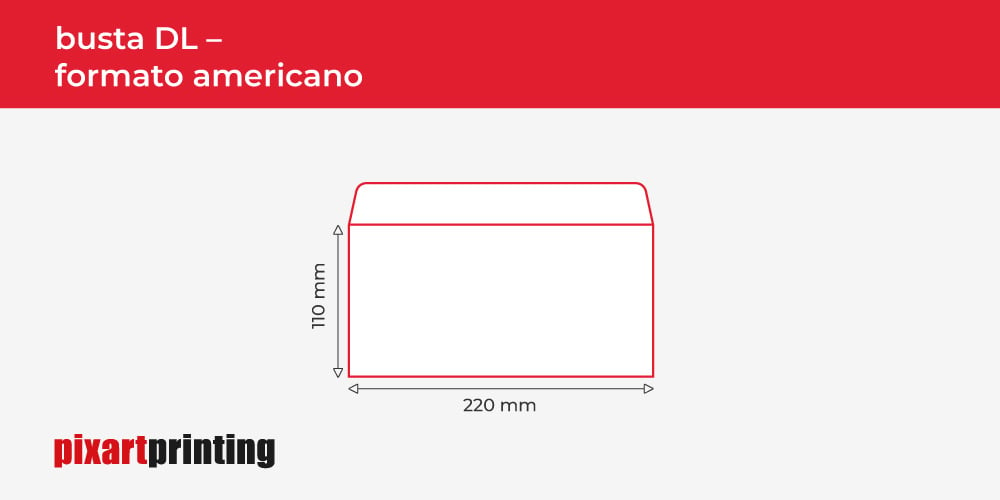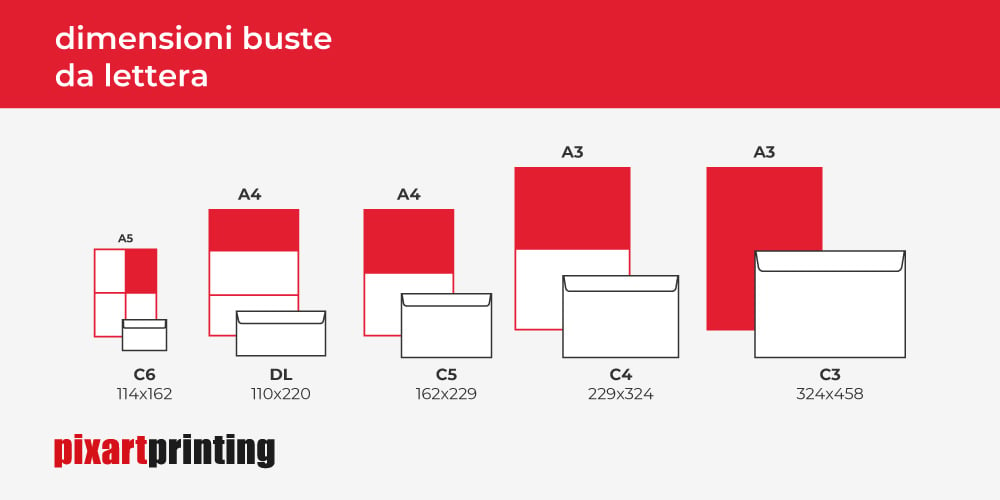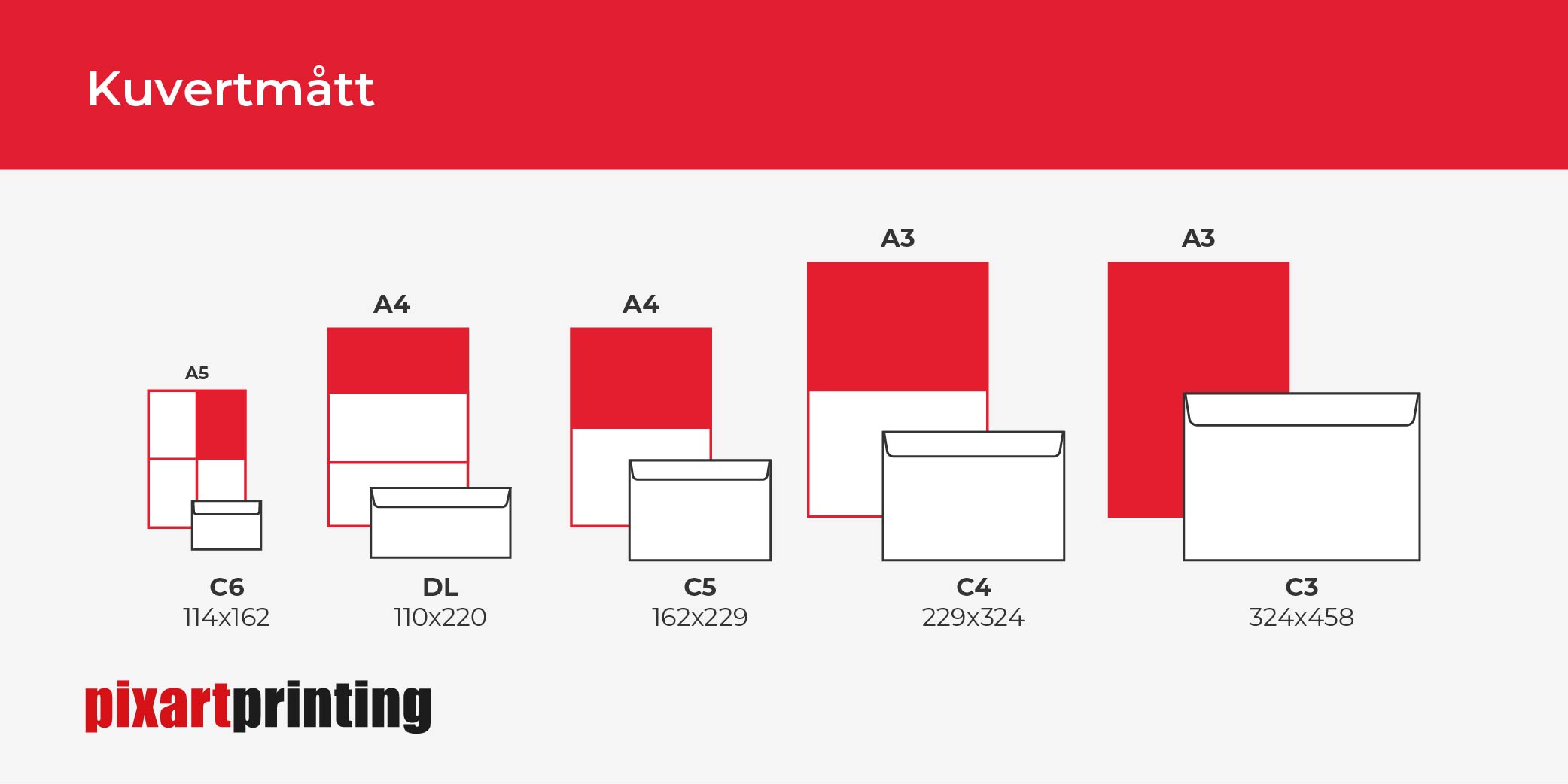Those who need to mail a letter need to figure out the size of the mailing envelope best suited to their needs.

The classic questions of those who need to mail a letter are twofold:
- What size is a letter envelope?
- What are the letter envelope sizes?
We will answer these questions so you can figure out right away which letter envelope is right for you.

Letter envelope sizes: the most common envelope size is the DL (American size)
The most common size of letter envelope is the format called DL (or American) which measures 11 x 22 centimeters.
The DL envelope is also called the American envelope and is mostly used for business communications.
The DL-size letter envelope has measurements suitable for holding an A4 sheet folded on itself in three parts. DL format is also called C6/5.

Other letter envelope sizes: alternatives to the American format
In addition to the popular American format, there are other types of letter envelopes commonly used.
The different formats differ in their ability to hold one or more sheets of paper folded in such a way that they fit comfortably.

Example:
- DL size is intended to accommodate an A4 sheet folded in three parts on itself.
- C3 size (32.4 X 45.8 CM) is suitable for mailing books.
- C4 size (22.9 X 32.4 CM) holds one A4 sheet, inserted entirely and without folding. It is suitable for holding 15 to 50 unfolded A4 sheets.
- C5 size (16.2 x 22.9 cm) holds one A5 sheet or one a4 sheet folded in half. Useful for holding long documents plus three pages by folding the sheets in half. It can also hold a small magazine, greeting cards larger than the classics, and printed photos.
- C6 size (11.4 x 16.23 cm) holds an A6 or A4 sheet folded in four. Ideal for holding small items such as usb flash drives or memory cards.
- C7 size ( 8.3 x 11.2 cm) is suitable for holding an A7 sheet or a greeting card.

Postal standard dimensions: the international standard ISO 269
As with paper sizes, there is an international standard for envelope sizes, ISO 269, which codifies letter envelope sizes so that they are universally known, understood and applied. In this motion, postal services in all countries can coordinate to deliver envelopes whose measurements are clearly known and applied.
This table summarizes the most common letter envelope sizes according to the ISO 269 standard.
| SIZE | DIMENSIONS (CM) | CONTENT FORMAT |
|---|---|---|
| | | |
| DL | 110 X 120 | 1/3 A4 |
| C7/C6 | 81 X 162 | 1/3 A5 |
| C6 | 114 X 162 | A6 (O A4 piegato due volte a metà) |
| C6/C5 | 114 X 229 | 1/3 A4 |
| C5 | 162 X 229 | A5 (o A4 piegato a metà) |
| C4 | 229 X 324 | A4 |
| C3 | 324 X 458 | A3 |
| B6 | 125 X 176 | C6 |
| B5 | 176 X 250 | C5 |
| B4 | 250 X 353 | C4 |
| E3 | 280 X 400 | B4 |
Special envelope formats
In the custom envelope landscape, Pixartprinting offers a wide range of options, each with distinct technical characteristics and specific contexts of use. Here are some notable examples:
- Commercial Envelopes: These envelopes are ideal for effective business communication, available in various sizes and with the option of adding a window.
- Sack envelopes: Perfect for sending larger documents, they offer convenience and security when transporting informational materials.
- Plein envelopes: With a fully customizable surface, they are ideal for advertising campaigns or special events, offering great visual impact.
- Ennobled envelopes: Featuring embossed details or metallic finishes, they add a touch of elegance and sophistication to corporate communications.
- Automatic envelopes: The practical choice for those looking for envelopes that are easy to prepare and send, ideal for quick mailing operations.
- Tyvek® Envelopes: Innovative, water- and tear-resistant material perfect for valuable mailings or those requiring extra protection.
- Invitation Envelopes: Specifically designed for events, with personalization options that make them the ideal tool for making a memorable first impression.
- Cardboard envelopes: They offer superior strength for sending important documents or small items, protecting them in transit.
- Plastic envelopes: Ideal for shipments requiring waterproofing and durability, suitable for long journeys or unfavorable environmental conditions.
- Colored shipping envelopes: To add a touch of vibrancy and stand out, these envelopes are perfect for promotional mailings or special packages.
Each type of envelope is designed to meet different needs, from simple business correspondence to sending promotional materials, valuable documents or items. The choice of format and material will therefore depend on the specific use to be made of it, as well as the desired visual impact.
To write a detailed paragraph on “Envelope Closure Types,” including various types with descriptions, I would need to consult specific sources of information or additional details not found on the open pages. However, I can provide a general idea based on common knowledge:
Types of letter envelope closures
Letter envelopes can have different types of closures, each suitable for specific security, convenience, or aesthetic needs:
- Wet seal: Requires moistening the glue strip to seal the envelope. This is the traditional method, widely used for official or business correspondence.
- Self-adhesive closure: Features an adhesive strip protected by a removable film. Provides a quick and convenient closure, ideal for frequent use.
- Silicone Closure: Consists of two silicone strips that stick together once the protectors are removed. This type of closure is reusable and very secure.
- Button and buttonhole closure: Uses a button and buttonhole to close the envelope, providing an elegant and traditional look, often used for invitations or important documents.
- String Closure: Features a string wrapped around two cardboard discs to close the envelope, combining security with a vintage feel.
Each type of closure has its advantages, with some options offering more security or ease of use than others, depending on mailing or presentation needs.

